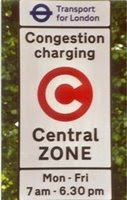London Will Triple Congestion Charge on Some Cars
 London Mayor Ken Livingstone, architect of London’s “congestion pricing” scheme that assesses fees on vehicles entering central London since 2003, has taken his idea a step farther.
London Mayor Ken Livingstone, architect of London’s “congestion pricing” scheme that assesses fees on vehicles entering central London since 2003, has taken his idea a step farther.
Initially, congestion pricing only applied to central London and was £5 (about $10). Later, the price increased to £8 (about $16) and the congestion area encompassed a larger portion of the city. Earlier this month, a charge of £200 ($392)was assessed on the most polluting trucks that enter the city center.
Mr. Livingstone’s latest initiative with the congestion zone is to assess the “most polluting” passenger cars that enter the congestion pricing zone with a £25 ($49) fee. He doesn’t have (at least to my American tastes) the most obnoxious, carbon-spewing vehicles in his target, either. According to Bloomberg, some vehicles in the so-called Band G that will be hit by the higher fees starting October 29 include the Ford Mondeo V6, BMW 335i convertible, BMW 545i and 730i sedans, and the Land Rover Discovery and Range Rover Sport SUVs.
Meanwhile, the congestion charge will be waived for drivers of the least-polluting vehicles such as the Toyota Prius, Vauxhall Corsa, and Peugeot 107 models. Mr. Livingstone himself drives a Prius.
I’ve already given my opinion of possible congestion pricing in Manhattan, and my opinion of it has certainly not been tempered since last July. Yes, it has reduced the number of vehicles entering central London by about 70,000 per day, but I have a fundamental problem of paying $49 for the privilege of driving in a city (which, let’s be frank, usually sucks anyway). That doesn’t take into account the cost of fuel or the cost of parking. It’s virtually impossible for a middle-class person to commute by car into London’s congestion zone, and especially if they have a larger family and need a larger vehicle.
Another irony is that congestion is actually increasing in the congestion pricing zone because more lanes are being dedicated to bicycles and buses, resulting in many of the same types of traffic jams that existed prior to 2003.
Finally, Mr. Livingstone doesn’t seem to understand that CO2 emissions and “pollution” are not the same thing. CO2 is reduced only by driving a vehicle with a smaller engine. Pollution can be cleaned up with catalytic converters and particulate filters. It’s entirely possible for a large, powerful engine to emit less smog-forming pollution than a small, less sophisticated engine. Don’t believe me? Start your V6 powered family sedan in a closed garage and let it idle for 30 seconds – not much smell or smoke, right? Then start a gasoline-powered lawn mower in the same closed garage and run it for 30 seconds. Even though the lawnmower’s engine is less than 1/10th as large as the car’s, it’s emitting far more smoke and pollution (though less CO2). So reducing the CO2 output of the vehicles entering London will save fuel and possibly help with global warming, but they won’t do a thing about pollution.




